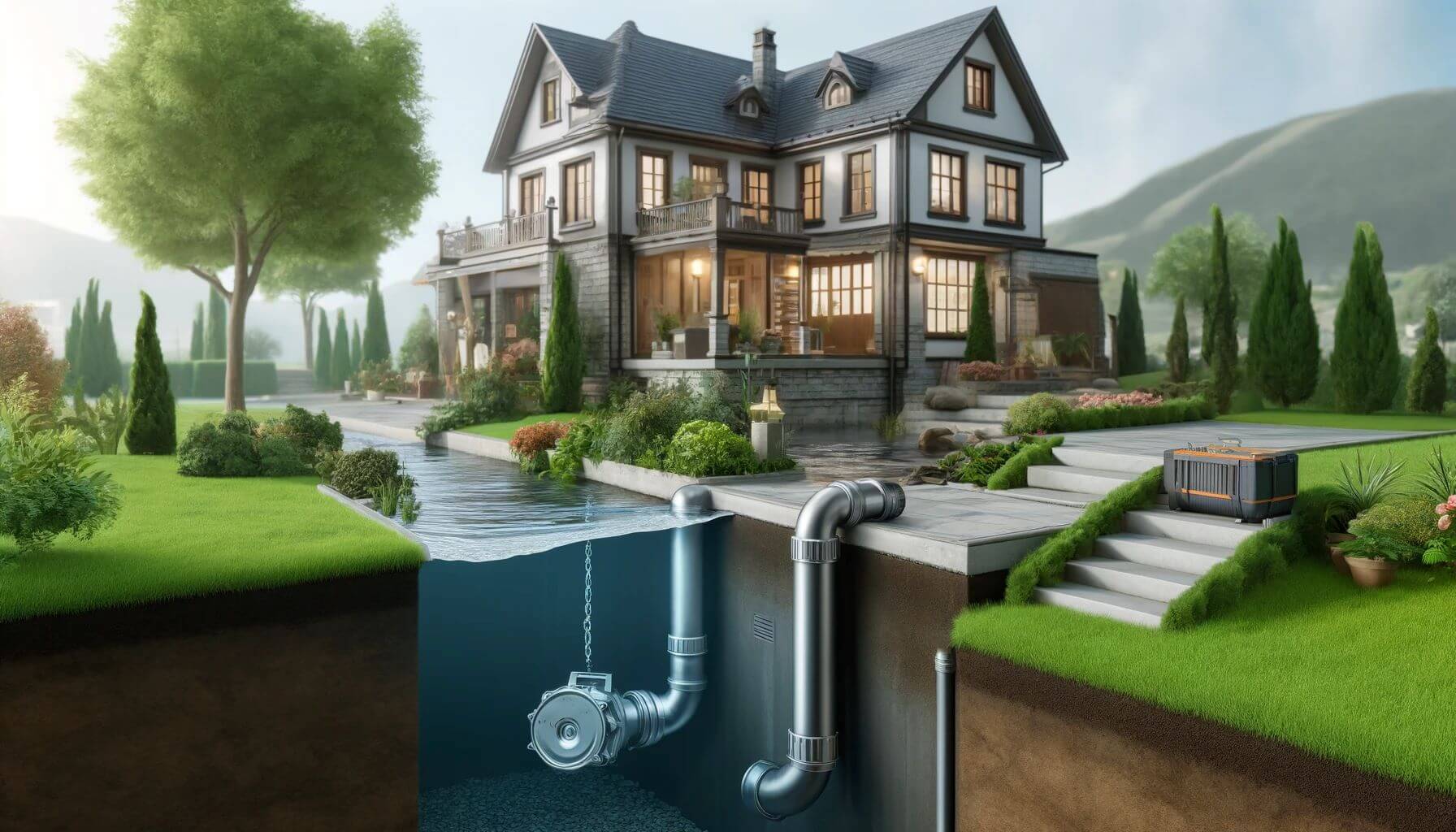
Efficient sump pump discharge management is crucial for maintaining a dry and healthy home environment. Proper installation and maintenance ensure that water is effectively diverted away from your home’s foundation, preventing potential damage and costly repairs. Let’s explore why it’s essential to optimize your sump pump system and how it benefits your property.
Understanding Sump Pumps and Their Functions
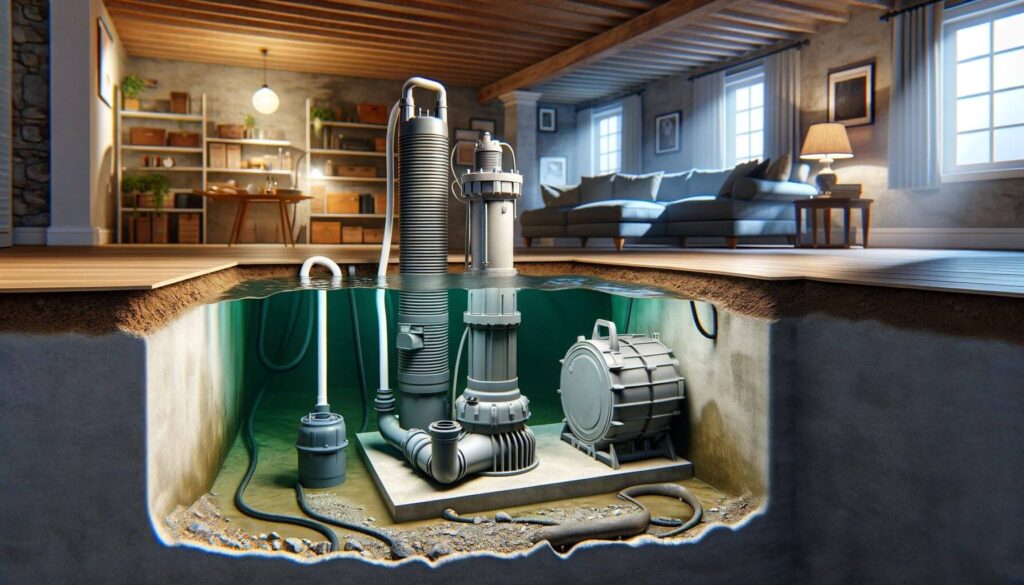
What is a Sump Pump?
A sump pump is a pivotal component of home drainage systems, particularly in areas prone to basement flooding. Positioned at the lowest part of your basement or crawl space, it pumps out water that accumulates in the sump basin, directing it away from your home through a discharge pipe. This process is vital for keeping the area under your home dry and preventing water damage.
Types of Sump Pumps
There are two main types of sump pumps: submersible and pedestal.
Submersible sump pumps
Are designed to operate underwater in your sump pit. This makes them quieter and more efficient, ideal for residential use where noise is a concern.
Pedestal sump pumps
Have their motors located above the pit, which makes them easier to maintain and less expensive but noisier and less powerful. Choosing the right type depends on your specific needs, including the typical water volume and the size of the sump pit.
Each type of pump plays a crucial role in home flood prevention, and understanding which one best fits your home’s requirements is the first step toward ensuring effective water management.
Key Considerations for Sump Pump Installation
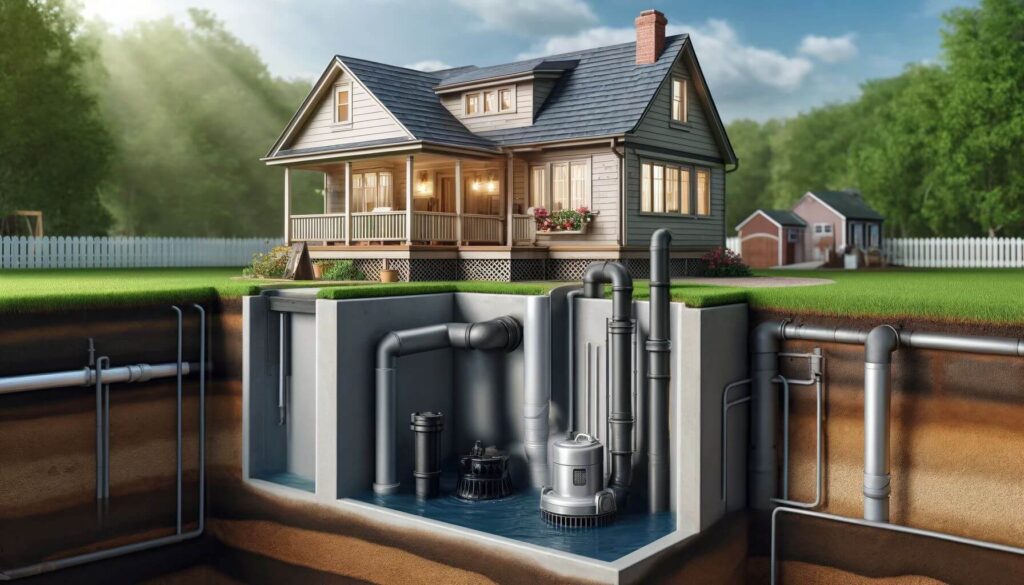
Choosing the Right Size and Type
Selecting the right size and type of sump pump is critical to ensure effective water evacuation from your property. The sump pump pipe size and what size pipe for sump pump discharge are essential factors that affect the flow rate and efficiency of water management. A too-small discharge pipe will restrict flow and may cause the pump to work harder, reducing its lifespan. Conversely, an overly large pipe could decrease the velocity of water flow, leading to sediment buildup in the pipe.
Location and Setup
The placement of your sump pump is another crucial consideration. For homes with existing basements, an underground sump pump is a common solution, as it can be integrated into the lowest part of the basement, ensuring all perimeter drainage systems converge at this point. For homes without basements or in flood-prone areas, installing a sump pump outside can also be an effective way to manage surface water and prevent it from entering the home.
Comprehensive Guide to Sump Pump Discharge Options
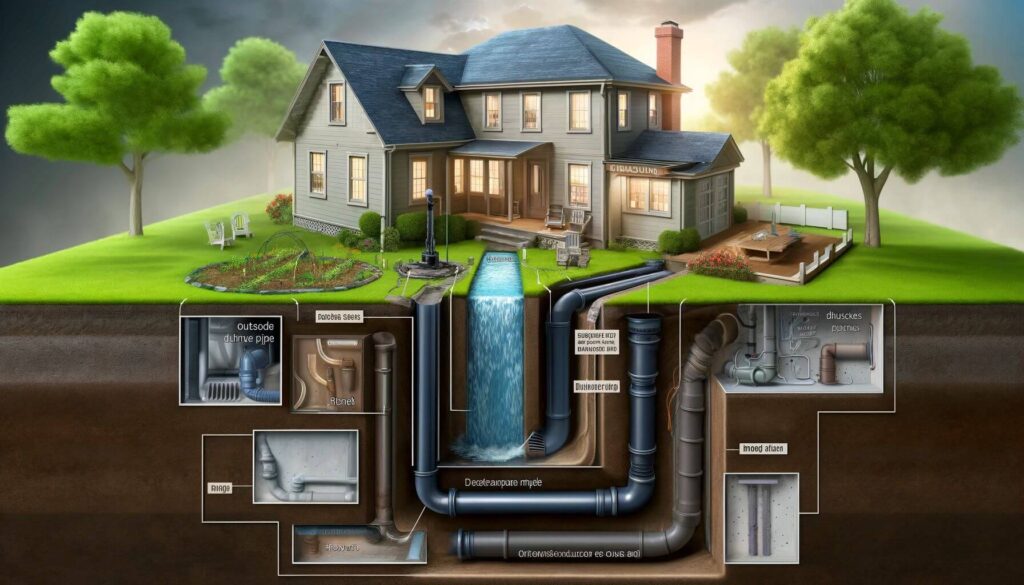
Exploring Various Discharge Ideas
Effective management of sump pump discharge is key to maintaining the structural integrity of your property. Various sump pump discharge ideas include routing the water into a dry well, a rain garden, or directly into a storm drain, provided local regulations permit. Each option has its merits and can be chosen based on the specific needs and environmental conditions of your property.
Selecting and Installing the Right Discharge Pipe
Choosing the right sump pump discharge pipe is crucial for efficient operation. The sump pump discharge pipe size should match the pump’s specifications to ensure optimal performance. Installing the sump pump discharge pipe outside requires careful planning to ensure the discharge point is away from the house foundation and does not cause water to pool or re-enter the basement. Also, proper slope and secure connections are crucial to avoid leaks and ensure that water is directed away from the property effectively.
Sump Pump Discharge Best Practices
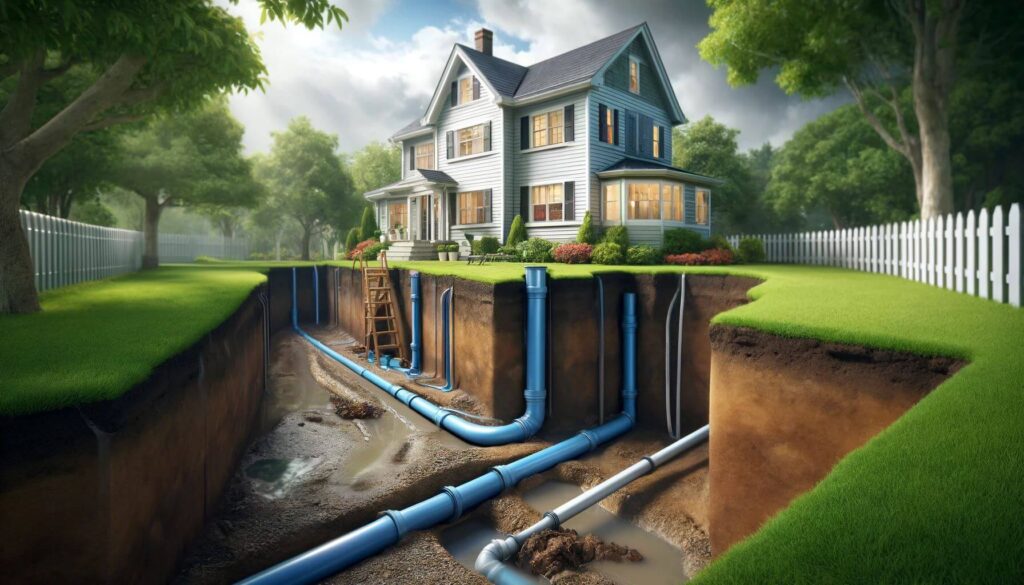
Proper Routing of Sump Pump Discharge Lines
Ensuring that your sump pump’s discharge line is correctly routed is vital to prevent water from re-entering your home. The discharge line should extend at least 10 feet from the foundation to ensure the water flows away from, not towards, your home. Where to drain sump pump output is crucial. Ideally, you should direct it towards a street drain or a designated soakaway area. This is where sump pump water goes should not compromise the structural integrity of your home or affect neighboring properties.
Benefits of Burying Sump Pump Discharge Lines
Burying the sump pump discharge line can be highly beneficial, particularly in terms of aesthetics and safety, eliminating tripping hazards and protecting the pipe from damage. Bury sump pump discharge line practices include installing the pipe at least 12 inches below the frost line to prevent freezing. How deep to bury sump pump discharge line depends on local climate conditions and soil types but generally ranges from 12 to 18 inches to ensure effective drainage and prevent freezing during colder months.
Troubleshooting Common Sump Pump Discharge Issues
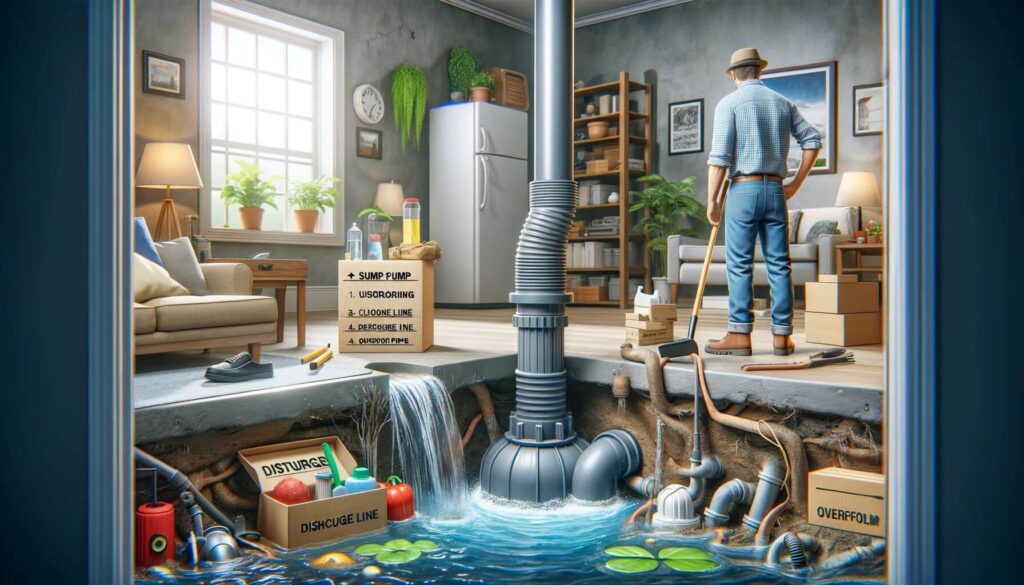
Addressing Potential Problems
Sump pump systems can encounter several issues, with clogging and freezing being the most common. A sump pump discharge line underground clogged can lead to backups and flooding, particularly during heavy rainfall. Regular maintenance and checks are essential to keep the system clear of debris. If the sump pump discharge pipe is overflowing, this may indicate a blockage or a pump issue, such as an inadequate flow rate or a malfunctioning pump.
Solutions for Overflow and Backup
To manage sump pump overflow, installing a backup system with an alarm can alert homeowners to potential overflow, allowing them to address the issue promptly. Additionally, you can use a sump pump discharge overflow relief system to divert excess water away safely when the primary outlet is compromised. Ensuring that the sump pump’s capacity and discharge line size are adequate for the expected water volume is also crucial to prevent these issues.
Innovative Discharge Solutions and Enhancements
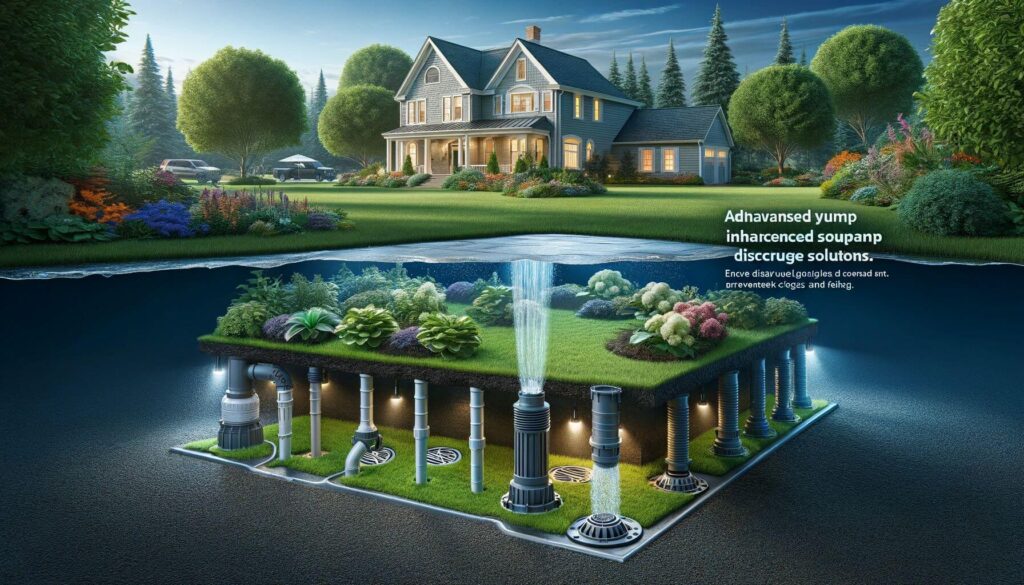
Advanced Discharge Management Products
Innovative products like IceGuard and Lawnscape outlets provide enhanced discharge management by preventing common issues associated with freezing temperatures and landscape integration. IceGuard allows water to escape from the discharge line even if it is blocked by ice, ensuring that the sump pump continues to operate effectively throughout the winter. Lawnscape outlets are discreetly designed to blend with your yard while effectively dispersing water away from your property.
Yard and Landscape-Friendly Discharge Solutions
Integrating sump pump discharge into your landscaping not only helps manage water effectively but can also enhance the aesthetics of your outdoor space. Sump pump discharge landscaping ideas include creating a rain garden or a decorative pond that benefits from the extra water, turning a functional necessity into a feature of your garden. Additionally, yard sump pump discharge ideas such as using decorative rocks or gravel to conceal the discharge end can seamlessly integrate these systems into your landscape design.
Maintaining Your Sump Pump System

Routine Checks and Maintenance Tips
Regular maintenance is key to ensuring the longevity and efficiency of your sump pump. How to check sump pump discharge line involves inspecting for signs of wear, clogs, or leaks and clearing debris from the intake and discharge areas. Also, seasonal sump pump maintenance should include testing the pump by pouring water into the pit to ensure it activates and pumps out the water quickly and completely.
When to Replace or Upgrade Parts
Over time, parts of your sump pump system may wear out and require replacement or upgrading. If you notice your sump pump pipe leaking, it’s crucial to replace it immediately to prevent water damage. Similarly, if the sump pump discharge line repair does not solve the issue, or if the system struggles to handle the volume of water during heavy rains, it may be time to consider upgrading to a larger or more powerful model to ensure adequate drainage and prevent potential flooding.
Legal and Environmental Considerations
Navigating Local Codes and Regulations
Understanding and adhering to local codes and regulations is crucial when installing and managing your sump pump discharge system. Regulations often address sump pump discharge rules, including prohibitions against draining into municipal sewer systems as this can overload public treatment facilities during heavy rainfall. It’s important to confirm whether it is legal to drain sump pump into sewer systems in your area or if alternative methods are mandated to prevent environmental and infrastructural issues.
Mitigating Environmental Impact
Improper sump pump discharge can lead to significant environmental concerns, such as water pollution and erosion in local waterways. To mitigate these impacts, consider environmentally friendly discharge methods that replenish the groundwater or use the discharge to irrigate landscapes, which can help maintain local ecosystems and reduce the burden on municipal stormwater systems.
Conclusion on Yard Sump Pump Discharge Ideas
Effectively managing your sump pump discharge is more than just a practical home maintenance task; it is crucial for protecting your property from water damage and contributing to a healthier local environment. By understanding the importance of proper sump pump installation, maintenance, and adherence to local regulations, homeowners can ensure their systems operate efficiently and responsibly.
We encourage all homeowners to take proactive measures. They can by performing regular maintenance checks and consulting with professionals. Furthermore, this will ensure their sump pump systems are optimized for performance and environmental compliance. Making informed decisions about your sump pump can save you from costly repairs and contribute positively to your community’s well-being.



